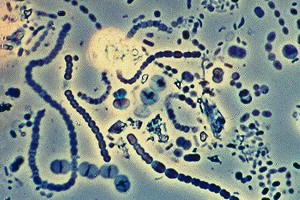Methylococcus capsulatus: Difference between revisions
| Line 23: | Line 23: | ||
==Genome structure== | ==Genome structure== | ||
"The genome of M. capsulatus (Bath) comprises a single circular molecule of 3,304,697 bp." | "The genome of M. capsulatus (Bath) comprises a single circular molecule of 3,304,697 bp." | ||
"One surprising outcome of the genome project is evidence suggesting the existence of previously unsuspected metabolic flexibility in M. capsulatus, including an ability to grow on sugars, oxidize chemolithotrophic hydrogen and sulfur, and live under reduced oxygen tension, all of which have implications for methanotroph ecology. The availability of the complete genome of M. capsulatus (Bath) deepens our understanding of methanotroph biology and its relationship to global carbon cycles." | "One surprising outcome of the genome project is evidence suggesting the existence of previously unsuspected metabolic flexibility in M. capsulatus, including an ability to grow on sugars, oxidize chemolithotrophic hydrogen and sulfur, and live under reduced oxygen tension, all of which have implications for methanotroph ecology. The availability of the complete genome of M. capsulatus (Bath) deepens our understanding of methanotroph biology and its relationship to global carbon cycles." | ||
Revision as of 20:00, 3 May 2007
A Microbial Biorealm page on the genus Methylococcus capsulatus
Classification
Higher order taxa
Kingdom: Bacteria Domain: Proteobacteria Phylum: Gammaproteobacteria Class: Methylococcales Order: Methylococcaceae Family: Methylococcus
Species
species Methylococcus capsulatus
Description and significance
Methylococcus capsulatus is a methylotrophic gram-negative bacterium with coccus shape, live in multiple habitate, however, oxygen is the necessity for such cell to survive. Methylococcus capsulatus is also a thermophilic microbe which optically live in the temperature of 45C.

Genome structure
"The genome of M. capsulatus (Bath) comprises a single circular molecule of 3,304,697 bp."
"One surprising outcome of the genome project is evidence suggesting the existence of previously unsuspected metabolic flexibility in M. capsulatus, including an ability to grow on sugars, oxidize chemolithotrophic hydrogen and sulfur, and live under reduced oxygen tension, all of which have implications for methanotroph ecology. The availability of the complete genome of M. capsulatus (Bath) deepens our understanding of methanotroph biology and its relationship to global carbon cycles."
Cell structure and metabolism
Describe any interesting features and/or cell structures; how it gains energy; what important molecules it produces.
Ecology
Describe any interactions with other organisms (included eukaryotes), contributions to the environment, effect on environment, etc.
Pathology
How does this organism cause disease? Human, animal, plant hosts? Virulence factors, as well as patient symptoms.
Application to Biotechnology
Does this organism produce any useful compounds or enzymes? What are they and how are they used?
Current Research
Enter summaries of the most recent research here--at least three required
Edited by Ting Yuan Feng, student of Rachel Larsen at UCSD.
